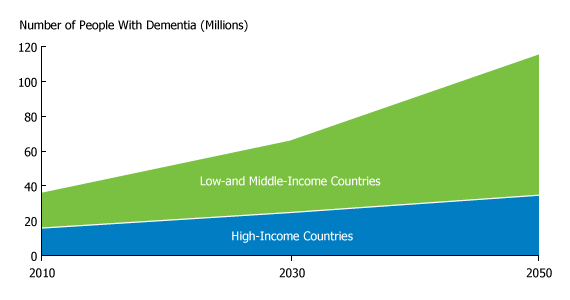
Dementia Cases Expected to Triple by 2050 as World Population Ages
(November 2012) Across the globe, more than 35 million people are living with dementia, according to recent World Health Organization (WHO) estimates.1 This number is expected to more than triple to reach 115 million by 2050 in the wake of world population aging.
Fueled by declines in fertility and increases in life expectancy, the share of the world’s population ages 65 and older is on track to jump from 8 percent today to nearly 17 percent in 2050, according to new U.S. Census Bureau population projections.
By 2050, the population of every world region except Africa will resemble Europe’s today, with elderly ages 65 and older outnumbering children younger than 15, reported the Census Bureau. This shift toward an older population brings with it changes in disease patterns: The share of deaths from infectious diseases of childhood are decreasing while the share from noncommunicable diseases of adulthood, including dementia, are on the rise.
Dementia is a brain disease characterized by loss of memory, speech, reasoning, and other cognitive functions; Alzheimer’s disease is the most common form likely accounting for 70 percent of all cases. The onset of dementia is devastating for individuals and their families, profoundly affecting the quality of life and taking a severe economic toll. Treating and caring for people with dementia currently costs more than US$600 billion per year worldwide (1 percent of world gross domestic product), according to WHO. This estimate includes the cost of providing health and social care as well as the reduction or loss of income of people with dementia and their caregivers.
While dementia affects people worldwide, more than half (58 percent) are living in low- and middle-income countries.2 By 2050, this share is expected to rise to more than 70 percent (see figure). Dementia tends to be “absent from or low on the health agendas” of developing countries, according to WHO. Worldwide only eight countries currently have national programs in place to address dementia. WHO and the nonprofit Alzheimer’s Disease International have urged countries to focus on improving early diagnosis, raising public awareness about the disease, reducing stigma, and providing better care to people living with dementia and more support to their caregivers.
Projected Numbers of People With Dementia, by Country Income Level, 2010 to 2050

Source: Alzheimer’s Disease International, World Alzheimer Report 2010, accessed on July 11, 2012.
Dementia Levels Likely Underestimated in Developing Countries
WHO reports that the estimated prevalence of dementia among people ages 60 and older tends to range between 5 percent and 7 percent in most countries. But some studies find age-adjusted dementia prevalence as low as about 2 percent in parts of sub-Saharan Africa and as high as 8 percent or more in parts of Latin America.
One explanation for low levels of dementia in some poor countries is that older people who survive childhood under harsh conditions may have a health advantage that also protects them from dementia. But a new study suggests that the tools traditionally used to diagnose dementia may not produce accurate results in some cultural settings.
A new approach to diagnosing dementia, tested in a variety of cultures, appears to be sensitive to mild and moderate cases and to be accurate among people with little or no education. Results using this approach suggest that the incidence of dementia in developing countries is 1.5 times to 2.5 times higher than that calculated using conventional Western diagnostic criteria.3 Previous studies using the Western criteria indicated that the incidence of dementia (the number of new dementia cases over a given time) might be considerably lower in low- and middle-income countries than in high-income countries.
In results published recently inThe Lancet, the 10/66 Dementia Research Group (coordinated by King’s College London) applied both dementia criteria to nearly 12,800 people ages 65 years and older across nine rural and urban sites in Cuba, the Dominican Republic, Venezuela, Peru, Mexico, and China. After taking population age structure into account, the incidence of dementia identified using the new cross-culturally sensitive criteria was consistently similar to, or higher than, dementia incidence previously observed in European countries.
Education Differences May Explain Gender Gap
The 10/66 Dementia Research Group study also suggests that education provides protection from dementia in low- and middle-income countries; previous studies in high-income countries have demonstrated that educated people were less likely to develop dementia than their uneducated peers.
“Our studies provide supportive evidence for the cognitive reserve hypothesis—that better brain development can mitigate the effects of neurodegeneration in later life,” said Martin Prince of King’s College London and the study’s director. “Our findings suggest that early life influences, education, and learning to read and write may be particularly important for reducing the risk of dementia in late life.”
Studies in developing countries find that men tend to outscore women on cognitive function tests that detect signs of dementia, even after adjusting for social, economic, and health factors. By contrast, women in industrialized countries tend to score the same as or better than men. Gender differences in education may be the reason. For example, differences in the levels of schooling achieved between boys and girls during childhood explained differences in cognitive functioning between older men and women in seven major urban areas in Latin America and the Caribbean.4 In this recent study, Jurgen Maurer examined men and women ages 60 and older and found that education in childhood and youth had a lasting impact on cognitive functioning in old age.
Similarly, older women in India also scored lower in cognitive function than men, according to findings from the 2010 pilot phase of the Longitudinal Aging Study in India (LASI).5 The study surveyed a representative sample of nearly 1,700 Indians ages 45 and older in four states (Karnataka, Kerala, Punjab, and Rajasthan), chosen to reflect the nation’s regional, cultural, and socioeconomic variation. The gender differences in cognitive functioning among southern Indians could be explained by disparities in education, health, and social engagement. But in northern India, the disparity between men and women persisted even after controlling for education and other risk factors linked to poor cognitive function, suggesting that the level of discrimination experienced by women in that region plays a role.
The researchers concluded that these findings have policy implications beyond India: “Greater access to education among girls and women has the potential to reduce gender disparities… Educating girls may improve cognitive health and alleviate health disparities observed later in life.”
Paola Scommegna is a senior writer/editor at the Population Reference Bureau.
References
- World Health Organization (WHO) and Alzheimer’s Disease International, Dementia: A Public Health Priority (Geneva: WHO, 2012).
- WHO and Alzheimer’s Disease International, Dementia: A Public Health Priority.
- Martin Prince et al., “Dementia Incidence and Mortality in Middle-Income Countries, and Associations With Indicators of Cognitive Reserve: A 10/66 Dementia Research Group Population-Based Cohort Study,” The Lancet 380, no. 9836 (2012): 50-58.
- Jurgen Maurer, “Education and Male-Female Differences in Later-life Cognition: International Evidence From Latin America and the Caribbean,” Demography 48, no. 3 (2011): 915-30.
- Jinkook Lee et al., “Cognitive Health of Older Indians: Individual and Geographic Determinants of Female Disadvantage,” in Aging in Asia: Findings From New and Emerging Data Initiatives, ed. James P. Smith and Malay Majmundar (Washington, DC: The National Academies Press, 2012).






